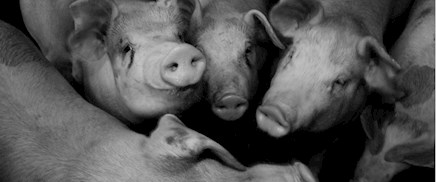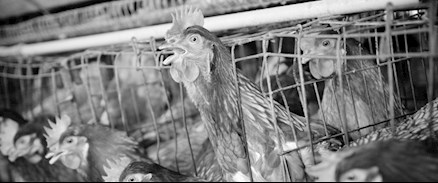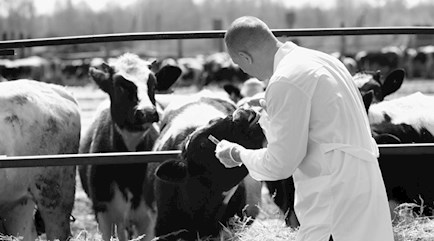What Percentage Of Antibiotics Are Used On Animals
Antibiotics and farming
Worldwide it is estimated that 66% of all antibiotics are used in farm animals, non people. Much of this use is routine, and enables farm animals, nigh often pigs and poultry just sometimes also cattle, to be kept in poor conditions where disease spreads easily. Leading regime such as the European Medicines Agency and the WHO say that the overuse of antibiotics in farming contributes to college levels of antibiotic resistance in some human infections.
Antibiotics have been used in livestock rearing for more than half dozen decades. In Europe, antibiotics were originally given to animals to boost their growth. Use of antibiotics for growth promotion was banned throughout the EU in 2006.According to the OIE, worldwide 118 countries no longer allow growth promotion, but information technology's even so immune in at least 35 countries.
In the United kingdom of great britain and northern ireland and beyond Europe, vast quantities of antibiotics are still used in farming . Farmers may even use antibiotics classed as 'critically important' for humans by the World Health System. What's more , while in man medicine antibiotics are used to cure the sick, in the farming sector these precious resources are ofttimes given to groups of healthy animals.
There has been some progress in Europe in recent years. Between 2011-2018 sales of antibiotics for livestock barbarous by a third. In 2022 the Eu is bringing in new regulations to end the routine utilise of antibiotics.
In the United kingdom of great britain and northern ireland, antibiotic use in livestock has fallen fifty% over the concluding five years.
In Asia, the Far E and Oceania, farm antibiotic sales per livestock unit are nearly four times higher than in Europe.
Antibiotics: an insurance-policy for intensive systems
The routine 'mass-medication' of animals enables them to stave off diseases in conditions which are oftentimes 'disease-inducing'.
Routine antibiotic apply is enabling the continuation of intensive farming systems, and fuelling the antibiotic resistance crunch in people.
In the Eu routine use of antibiotics will no longer be allowed from 2022. It is hoped that the United kingdom of great britain and northern ireland will adopt the same ban, but this is yet to be confirmed.In the United kingdom of great britain and northern ireland xxx% of all antibiotic apply is in farm animals and mass medication accounts for nigh 75% of antibiotic use.
Keeping animals salubrious through proficient practice
Animals do not need routine antibiotics to stay healthy. Organic and higher welfare systems use antibiotics sparingly, and only when animals need it. Livestock should - and tin can - be kept healthy through good husbandry and welfare, rather than through 'bought-in' amnesty.
Overwhelming show shows that animals are more susceptible to disease when stressed. Stress releases hormones such as cortisol in animals, which can reduce amnesty past compromising the immune system. In intensive systems, animals are often bred for maximum yield, rather than for natural illness resistance and robustness.
Where are antibiotics used?
Pigs

Pigs in intensive, indoor systems can receive antibiotics throughout their lives. Piglets are often given antibiotics preventatively at weaning, which occurs ordinarily at iii or four weeks, when pigs will often exist mixed and develop post-weaning diarrhoea.
Research shows that early weaned piglets are more likely to endure from diarrhoea as their 'abdominal barrier function' against pathogens is disrupted. Moving to after weaning would reduce the incidence of diarrhoea, which is a major cause of the loftier levels of antibiotic employ in weaners. Organic hog farms wean piglets later, and utilise much lower levels of antibiotics.
Poultry

Antibiotics are usually used in the poultry industry for the handling and prevention of respiratory diseases and other bacterial infections.
There have been pregnant reductions past the U.k. poultry industry to overall use of antibiotics in contempo years; just poultry farmers continue to use the fluoroquinolones - a class of antibiotics of import for treating serious homo Campylobacter infections. These may exist added to the drinking water of a flock, even when no disease is nowadays in nigh birds.
Countries including the US, Australia, Denmark and Sweden practise not use fluoroquinolones in poultry due to fears effectually human resistance. The Alliance is calling for a ban to use of these drugs in poultry in the UK.
Dairy

Antibiotics are ordinarily used in the dairy sector for 'dry cow therapy'. This involves infusing antibiotics into the udder to forbid the occurrence of mastitis during the 'dry out' period. Dry out cow therapy is often used across all cows equally a purely preventative measure out – even when in that location are no signs of affliction nowadays.
Research has shown that 85% of non-organic farms used routine, non-selective dry cow therapy in all their cows.
Dorsum to The Issue
Source: https://www.saveourantibiotics.org/the-issue/antibiotic-overuse-in-livestock-farming/
Posted by: ballauneance.blogspot.com

0 Response to "What Percentage Of Antibiotics Are Used On Animals"
Post a Comment